Project Lifecycle Risk Management: Hybrid Vehicle Development-RSK80006
VerifiedAdded on 2023/06/13
|12
|2680
|426
Report
AI Summary
This report discusses the interaction between project lifecycle and risk management, particularly in the context of hybrid passenger vehicle development. It outlines the four stages of a standard project lifecycle and contrasts them with the five stages of a service project lifecycle, emphasizing the importance of risk management at each stage. The report details risk assessment, mitigation, and contingency planning within the project lifecycle, using the development of a hybrid vehicle as a practical example. It identifies health, environmental, and economic risks associated with hybrid vehicle development and proposes a risk management plan involving risk assessment, analysis, and various risk management strategies like risk control, avoidance, sharing, and transfer. The implications of these risk control measures on the design team are also discussed. Desklib offers a wealth of similar solved assignments and past papers for students.

Running head: Risk Management 1
RISK MANAGEMENT
Student Name
Institution
RISK MANAGEMENT
Student Name
Institution
Secure Best Marks with AI Grader
Need help grading? Try our AI Grader for instant feedback on your assignments.
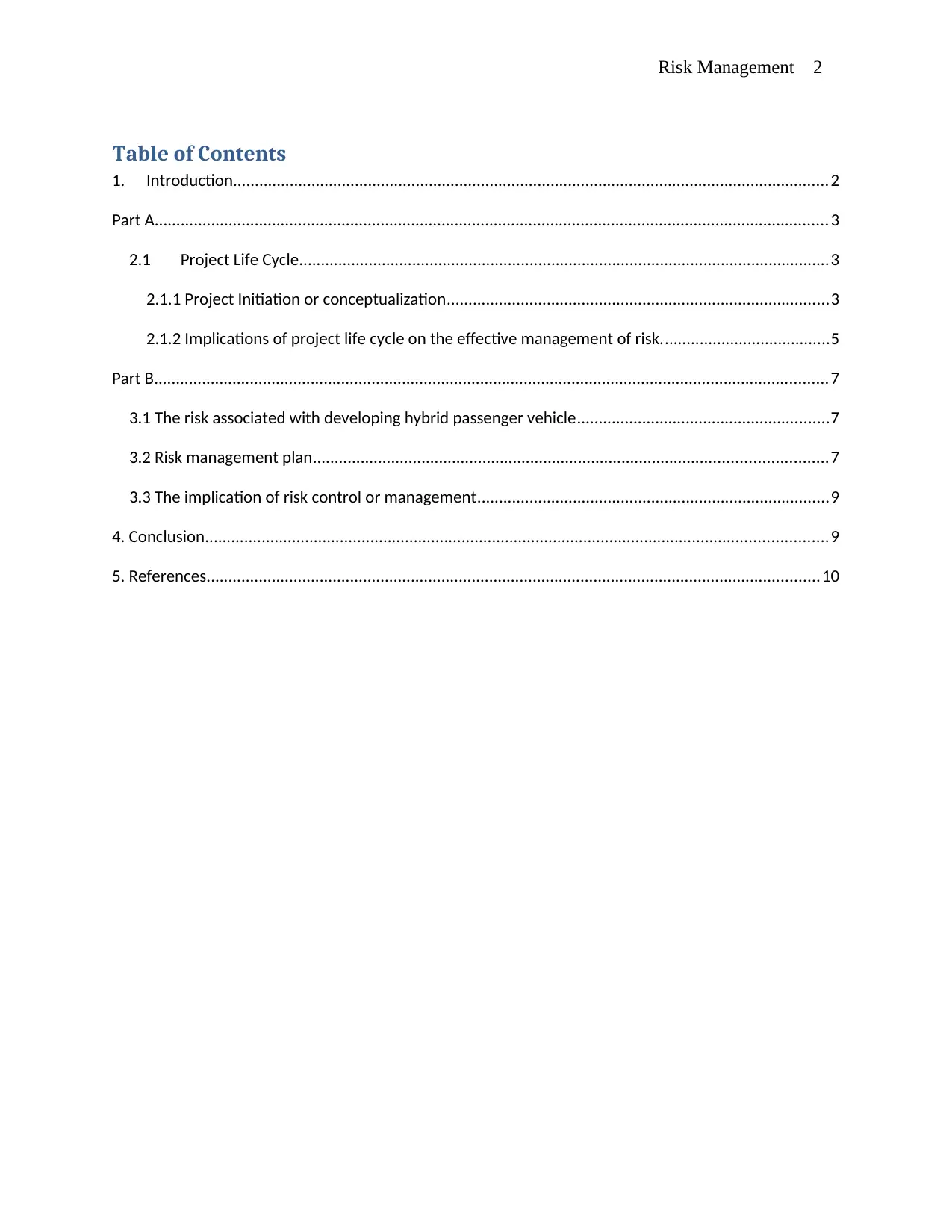
Risk Management 2
Table of Contents
1. Introduction.........................................................................................................................................2
Part A...........................................................................................................................................................3
2.1 Project Life Cycle..........................................................................................................................3
2.1.1 Project Initiation or conceptualization........................................................................................3
2.1.2 Implications of project life cycle on the effective management of risk.......................................5
Part B...........................................................................................................................................................7
3.1 The risk associated with developing hybrid passenger vehicle..........................................................7
3.2 Risk management plan......................................................................................................................7
3.3 The implication of risk control or management.................................................................................9
4. Conclusion...............................................................................................................................................9
5. References.............................................................................................................................................10
Table of Contents
1. Introduction.........................................................................................................................................2
Part A...........................................................................................................................................................3
2.1 Project Life Cycle..........................................................................................................................3
2.1.1 Project Initiation or conceptualization........................................................................................3
2.1.2 Implications of project life cycle on the effective management of risk.......................................5
Part B...........................................................................................................................................................7
3.1 The risk associated with developing hybrid passenger vehicle..........................................................7
3.2 Risk management plan......................................................................................................................7
3.3 The implication of risk control or management.................................................................................9
4. Conclusion...............................................................................................................................................9
5. References.............................................................................................................................................10
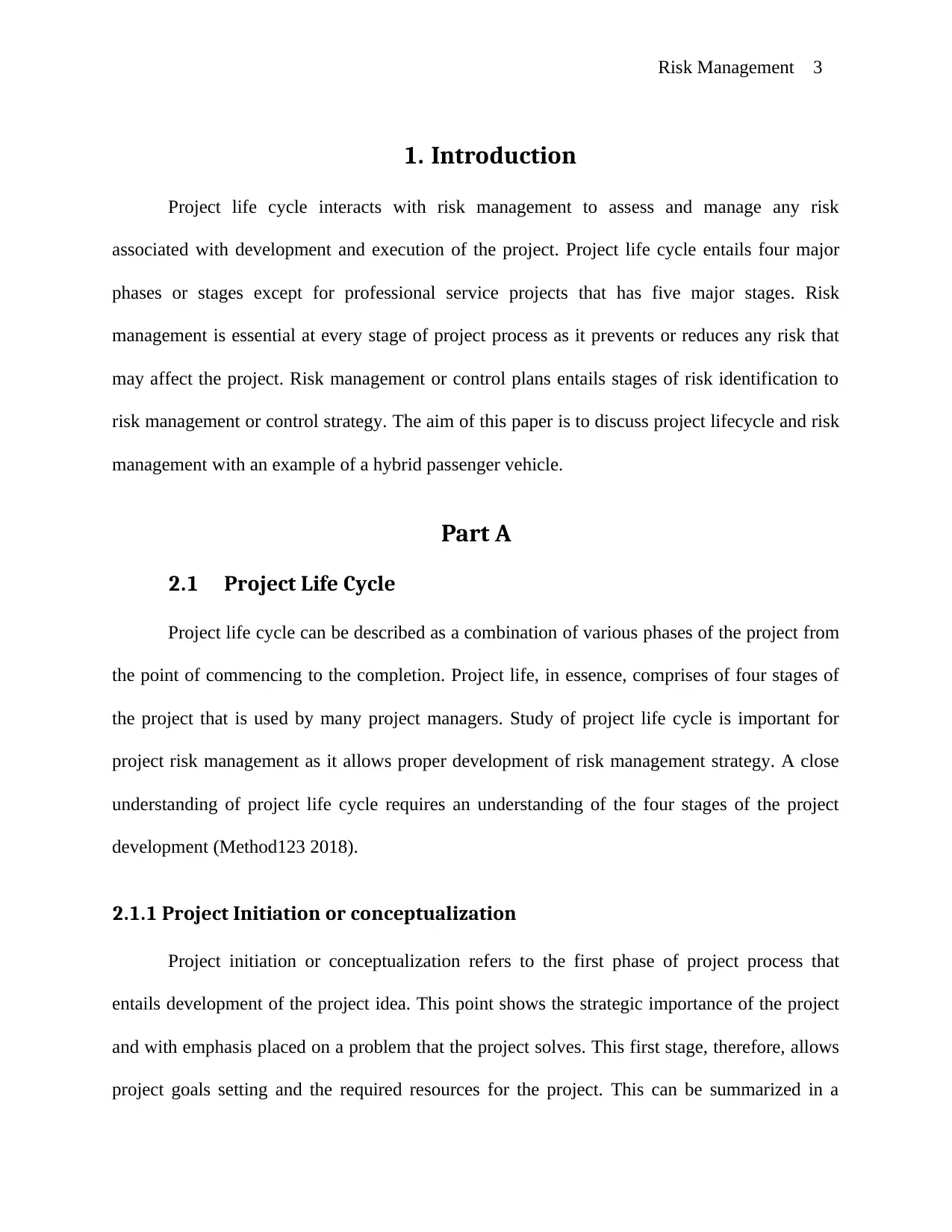
Risk Management 3
1. Introduction
Project life cycle interacts with risk management to assess and manage any risk
associated with development and execution of the project. Project life cycle entails four major
phases or stages except for professional service projects that has five major stages. Risk
management is essential at every stage of project process as it prevents or reduces any risk that
may affect the project. Risk management or control plans entails stages of risk identification to
risk management or control strategy. The aim of this paper is to discuss project lifecycle and risk
management with an example of a hybrid passenger vehicle.
Part A
2.1 Project Life Cycle
Project life cycle can be described as a combination of various phases of the project from
the point of commencing to the completion. Project life, in essence, comprises of four stages of
the project that is used by many project managers. Study of project life cycle is important for
project risk management as it allows proper development of risk management strategy. A close
understanding of project life cycle requires an understanding of the four stages of the project
development (Method123 2018).
2.1.1 Project Initiation or conceptualization
Project initiation or conceptualization refers to the first phase of project process that
entails development of the project idea. This point shows the strategic importance of the project
and with emphasis placed on a problem that the project solves. This first stage, therefore, allows
project goals setting and the required resources for the project. This can be summarized in a
1. Introduction
Project life cycle interacts with risk management to assess and manage any risk
associated with development and execution of the project. Project life cycle entails four major
phases or stages except for professional service projects that has five major stages. Risk
management is essential at every stage of project process as it prevents or reduces any risk that
may affect the project. Risk management or control plans entails stages of risk identification to
risk management or control strategy. The aim of this paper is to discuss project lifecycle and risk
management with an example of a hybrid passenger vehicle.
Part A
2.1 Project Life Cycle
Project life cycle can be described as a combination of various phases of the project from
the point of commencing to the completion. Project life, in essence, comprises of four stages of
the project that is used by many project managers. Study of project life cycle is important for
project risk management as it allows proper development of risk management strategy. A close
understanding of project life cycle requires an understanding of the four stages of the project
development (Method123 2018).
2.1.1 Project Initiation or conceptualization
Project initiation or conceptualization refers to the first phase of project process that
entails development of the project idea. This point shows the strategic importance of the project
and with emphasis placed on a problem that the project solves. This first stage, therefore, allows
project goals setting and the required resources for the project. This can be summarized in a
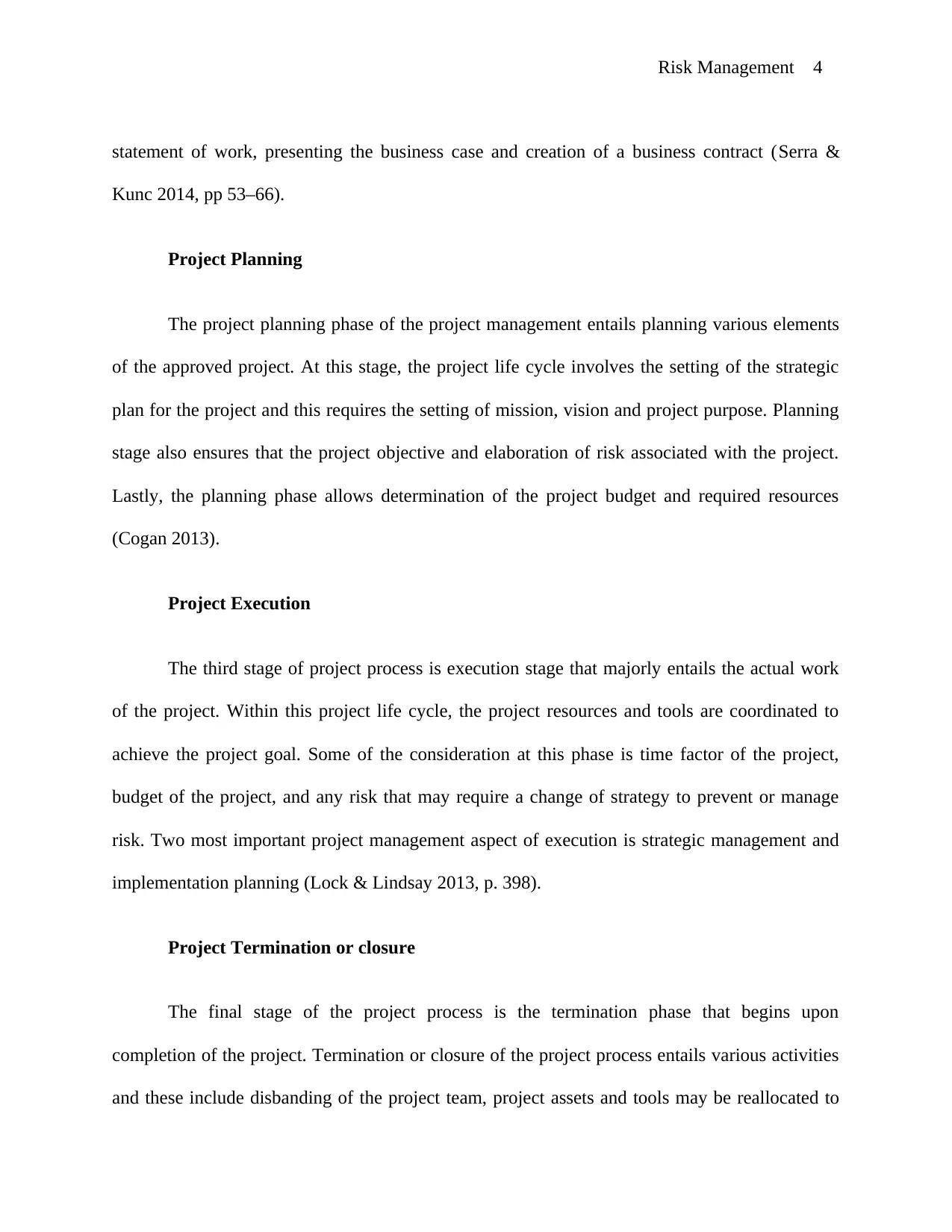
Risk Management 4
statement of work, presenting the business case and creation of a business contract (Serra &
Kunc 2014, pp 53–66).
Project Planning
The project planning phase of the project management entails planning various elements
of the approved project. At this stage, the project life cycle involves the setting of the strategic
plan for the project and this requires the setting of mission, vision and project purpose. Planning
stage also ensures that the project objective and elaboration of risk associated with the project.
Lastly, the planning phase allows determination of the project budget and required resources
(Cogan 2013).
Project Execution
The third stage of project process is execution stage that majorly entails the actual work
of the project. Within this project life cycle, the project resources and tools are coordinated to
achieve the project goal. Some of the consideration at this phase is time factor of the project,
budget of the project, and any risk that may require a change of strategy to prevent or manage
risk. Two most important project management aspect of execution is strategic management and
implementation planning (Lock & Lindsay 2013, p. 398).
Project Termination or closure
The final stage of the project process is the termination phase that begins upon
completion of the project. Termination or closure of the project process entails various activities
and these include disbanding of the project team, project assets and tools may be reallocated to
statement of work, presenting the business case and creation of a business contract (Serra &
Kunc 2014, pp 53–66).
Project Planning
The project planning phase of the project management entails planning various elements
of the approved project. At this stage, the project life cycle involves the setting of the strategic
plan for the project and this requires the setting of mission, vision and project purpose. Planning
stage also ensures that the project objective and elaboration of risk associated with the project.
Lastly, the planning phase allows determination of the project budget and required resources
(Cogan 2013).
Project Execution
The third stage of project process is execution stage that majorly entails the actual work
of the project. Within this project life cycle, the project resources and tools are coordinated to
achieve the project goal. Some of the consideration at this phase is time factor of the project,
budget of the project, and any risk that may require a change of strategy to prevent or manage
risk. Two most important project management aspect of execution is strategic management and
implementation planning (Lock & Lindsay 2013, p. 398).
Project Termination or closure
The final stage of the project process is the termination phase that begins upon
completion of the project. Termination or closure of the project process entails various activities
and these include disbanding of the project team, project assets and tools may be reallocated to
Secure Best Marks with AI Grader
Need help grading? Try our AI Grader for instant feedback on your assignments.
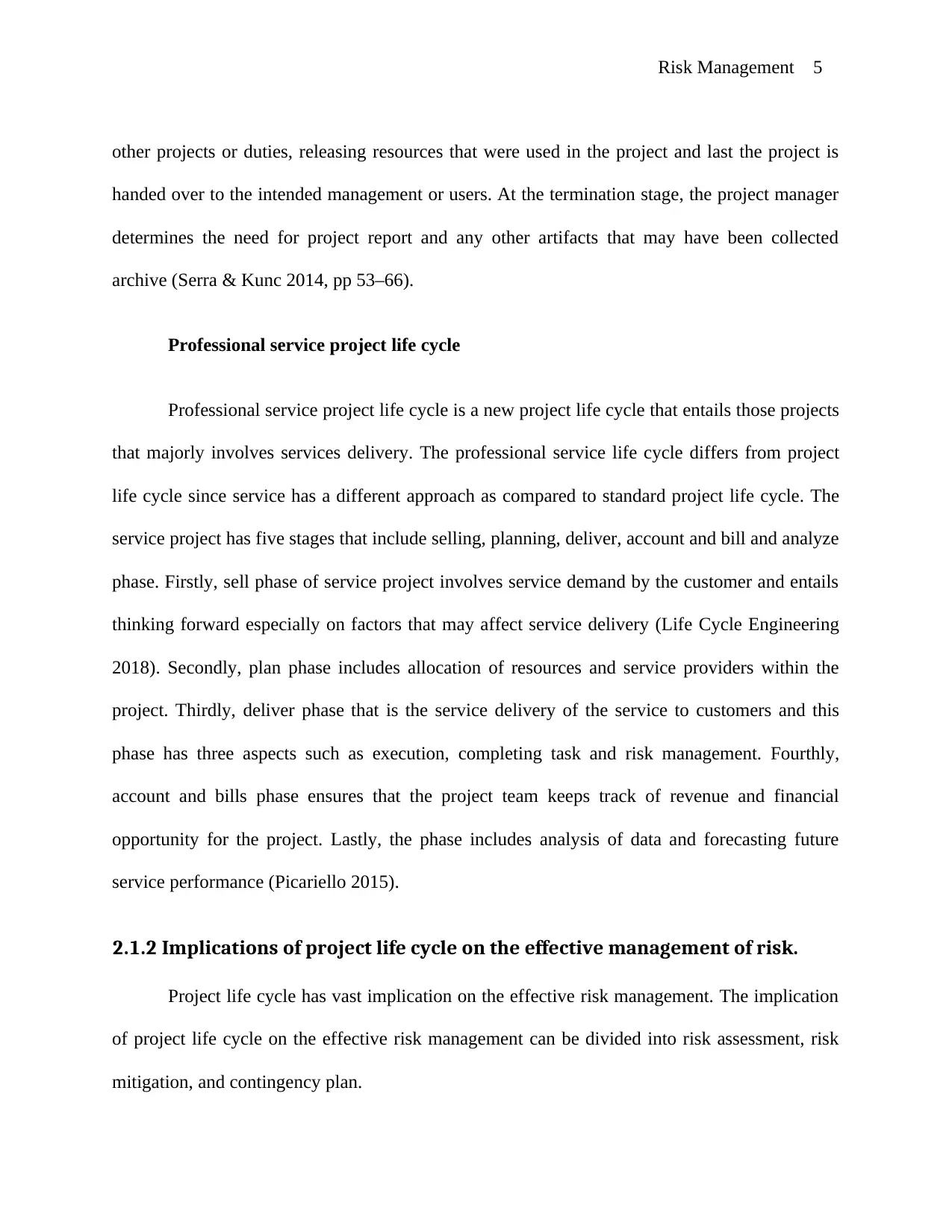
Risk Management 5
other projects or duties, releasing resources that were used in the project and last the project is
handed over to the intended management or users. At the termination stage, the project manager
determines the need for project report and any other artifacts that may have been collected
archive (Serra & Kunc 2014, pp 53–66).
Professional service project life cycle
Professional service project life cycle is a new project life cycle that entails those projects
that majorly involves services delivery. The professional service life cycle differs from project
life cycle since service has a different approach as compared to standard project life cycle. The
service project has five stages that include selling, planning, deliver, account and bill and analyze
phase. Firstly, sell phase of service project involves service demand by the customer and entails
thinking forward especially on factors that may affect service delivery (Life Cycle Engineering
2018). Secondly, plan phase includes allocation of resources and service providers within the
project. Thirdly, deliver phase that is the service delivery of the service to customers and this
phase has three aspects such as execution, completing task and risk management. Fourthly,
account and bills phase ensures that the project team keeps track of revenue and financial
opportunity for the project. Lastly, the phase includes analysis of data and forecasting future
service performance (Picariello 2015).
2.1.2 Implications of project life cycle on the effective management of risk.
Project life cycle has vast implication on the effective risk management. The implication
of project life cycle on the effective risk management can be divided into risk assessment, risk
mitigation, and contingency plan.
other projects or duties, releasing resources that were used in the project and last the project is
handed over to the intended management or users. At the termination stage, the project manager
determines the need for project report and any other artifacts that may have been collected
archive (Serra & Kunc 2014, pp 53–66).
Professional service project life cycle
Professional service project life cycle is a new project life cycle that entails those projects
that majorly involves services delivery. The professional service life cycle differs from project
life cycle since service has a different approach as compared to standard project life cycle. The
service project has five stages that include selling, planning, deliver, account and bill and analyze
phase. Firstly, sell phase of service project involves service demand by the customer and entails
thinking forward especially on factors that may affect service delivery (Life Cycle Engineering
2018). Secondly, plan phase includes allocation of resources and service providers within the
project. Thirdly, deliver phase that is the service delivery of the service to customers and this
phase has three aspects such as execution, completing task and risk management. Fourthly,
account and bills phase ensures that the project team keeps track of revenue and financial
opportunity for the project. Lastly, the phase includes analysis of data and forecasting future
service performance (Picariello 2015).
2.1.2 Implications of project life cycle on the effective management of risk.
Project life cycle has vast implication on the effective risk management. The implication
of project life cycle on the effective risk management can be divided into risk assessment, risk
mitigation, and contingency plan.
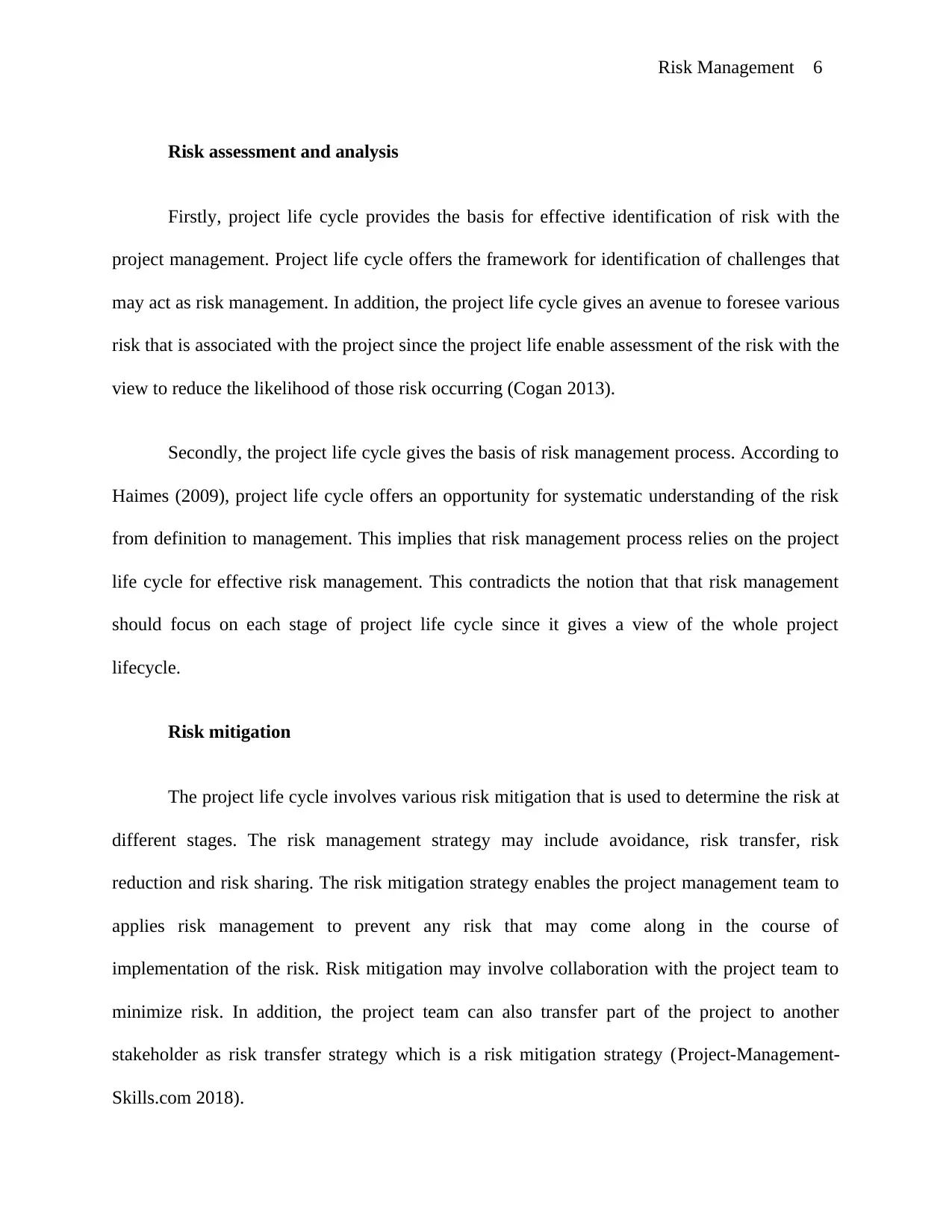
Risk Management 6
Risk assessment and analysis
Firstly, project life cycle provides the basis for effective identification of risk with the
project management. Project life cycle offers the framework for identification of challenges that
may act as risk management. In addition, the project life cycle gives an avenue to foresee various
risk that is associated with the project since the project life enable assessment of the risk with the
view to reduce the likelihood of those risk occurring (Cogan 2013).
Secondly, the project life cycle gives the basis of risk management process. According to
Haimes (2009), project life cycle offers an opportunity for systematic understanding of the risk
from definition to management. This implies that risk management process relies on the project
life cycle for effective risk management. This contradicts the notion that that risk management
should focus on each stage of project life cycle since it gives a view of the whole project
lifecycle.
Risk mitigation
The project life cycle involves various risk mitigation that is used to determine the risk at
different stages. The risk management strategy may include avoidance, risk transfer, risk
reduction and risk sharing. The risk mitigation strategy enables the project management team to
applies risk management to prevent any risk that may come along in the course of
implementation of the risk. Risk mitigation may involve collaboration with the project team to
minimize risk. In addition, the project team can also transfer part of the project to another
stakeholder as risk transfer strategy which is a risk mitigation strategy (Project-Management-
Skills.com 2018).
Risk assessment and analysis
Firstly, project life cycle provides the basis for effective identification of risk with the
project management. Project life cycle offers the framework for identification of challenges that
may act as risk management. In addition, the project life cycle gives an avenue to foresee various
risk that is associated with the project since the project life enable assessment of the risk with the
view to reduce the likelihood of those risk occurring (Cogan 2013).
Secondly, the project life cycle gives the basis of risk management process. According to
Haimes (2009), project life cycle offers an opportunity for systematic understanding of the risk
from definition to management. This implies that risk management process relies on the project
life cycle for effective risk management. This contradicts the notion that that risk management
should focus on each stage of project life cycle since it gives a view of the whole project
lifecycle.
Risk mitigation
The project life cycle involves various risk mitigation that is used to determine the risk at
different stages. The risk management strategy may include avoidance, risk transfer, risk
reduction and risk sharing. The risk mitigation strategy enables the project management team to
applies risk management to prevent any risk that may come along in the course of
implementation of the risk. Risk mitigation may involve collaboration with the project team to
minimize risk. In addition, the project team can also transfer part of the project to another
stakeholder as risk transfer strategy which is a risk mitigation strategy (Project-Management-
Skills.com 2018).
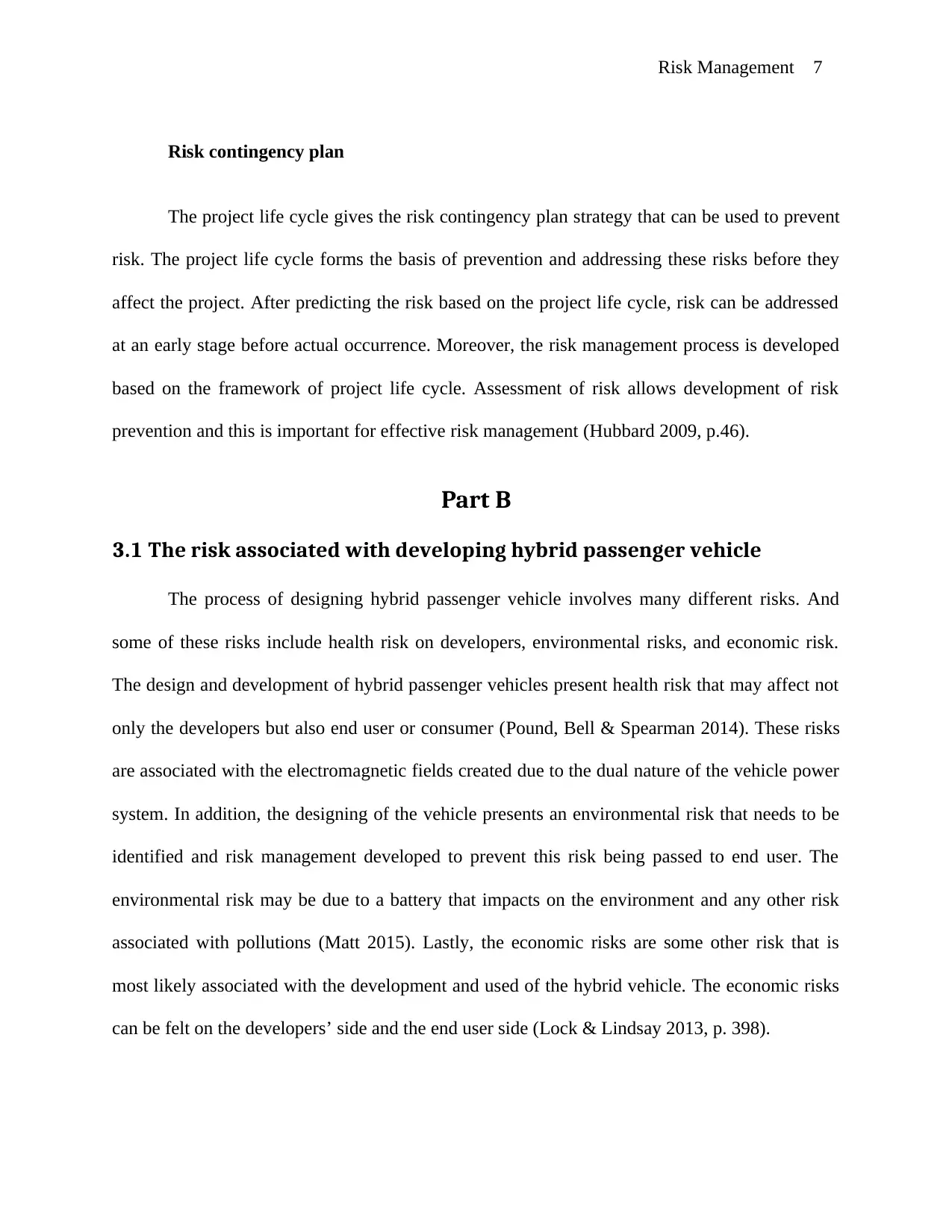
Risk Management 7
Risk contingency plan
The project life cycle gives the risk contingency plan strategy that can be used to prevent
risk. The project life cycle forms the basis of prevention and addressing these risks before they
affect the project. After predicting the risk based on the project life cycle, risk can be addressed
at an early stage before actual occurrence. Moreover, the risk management process is developed
based on the framework of project life cycle. Assessment of risk allows development of risk
prevention and this is important for effective risk management (Hubbard 2009, p.46).
Part B
3.1 The risk associated with developing hybrid passenger vehicle
The process of designing hybrid passenger vehicle involves many different risks. And
some of these risks include health risk on developers, environmental risks, and economic risk.
The design and development of hybrid passenger vehicles present health risk that may affect not
only the developers but also end user or consumer (Pound, Bell & Spearman 2014). These risks
are associated with the electromagnetic fields created due to the dual nature of the vehicle power
system. In addition, the designing of the vehicle presents an environmental risk that needs to be
identified and risk management developed to prevent this risk being passed to end user. The
environmental risk may be due to a battery that impacts on the environment and any other risk
associated with pollutions (Matt 2015). Lastly, the economic risks are some other risk that is
most likely associated with the development and used of the hybrid vehicle. The economic risks
can be felt on the developers’ side and the end user side (Lock & Lindsay 2013, p. 398).
Risk contingency plan
The project life cycle gives the risk contingency plan strategy that can be used to prevent
risk. The project life cycle forms the basis of prevention and addressing these risks before they
affect the project. After predicting the risk based on the project life cycle, risk can be addressed
at an early stage before actual occurrence. Moreover, the risk management process is developed
based on the framework of project life cycle. Assessment of risk allows development of risk
prevention and this is important for effective risk management (Hubbard 2009, p.46).
Part B
3.1 The risk associated with developing hybrid passenger vehicle
The process of designing hybrid passenger vehicle involves many different risks. And
some of these risks include health risk on developers, environmental risks, and economic risk.
The design and development of hybrid passenger vehicles present health risk that may affect not
only the developers but also end user or consumer (Pound, Bell & Spearman 2014). These risks
are associated with the electromagnetic fields created due to the dual nature of the vehicle power
system. In addition, the designing of the vehicle presents an environmental risk that needs to be
identified and risk management developed to prevent this risk being passed to end user. The
environmental risk may be due to a battery that impacts on the environment and any other risk
associated with pollutions (Matt 2015). Lastly, the economic risks are some other risk that is
most likely associated with the development and used of the hybrid vehicle. The economic risks
can be felt on the developers’ side and the end user side (Lock & Lindsay 2013, p. 398).
Paraphrase This Document
Need a fresh take? Get an instant paraphrase of this document with our AI Paraphraser
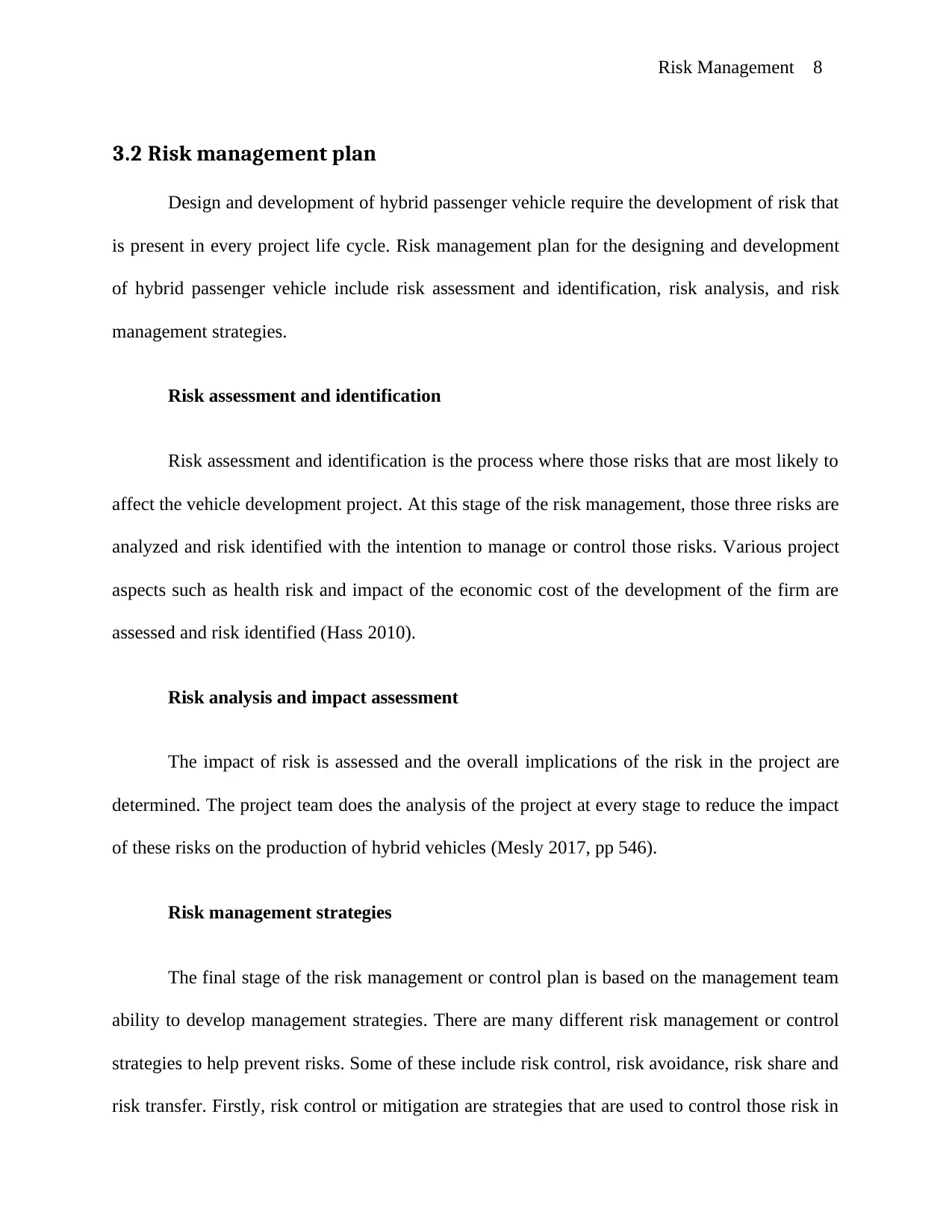
Risk Management 8
3.2 Risk management plan
Design and development of hybrid passenger vehicle require the development of risk that
is present in every project life cycle. Risk management plan for the designing and development
of hybrid passenger vehicle include risk assessment and identification, risk analysis, and risk
management strategies.
Risk assessment and identification
Risk assessment and identification is the process where those risks that are most likely to
affect the vehicle development project. At this stage of the risk management, those three risks are
analyzed and risk identified with the intention to manage or control those risks. Various project
aspects such as health risk and impact of the economic cost of the development of the firm are
assessed and risk identified (Hass 2010).
Risk analysis and impact assessment
The impact of risk is assessed and the overall implications of the risk in the project are
determined. The project team does the analysis of the project at every stage to reduce the impact
of these risks on the production of hybrid vehicles (Mesly 2017, pp 546).
Risk management strategies
The final stage of the risk management or control plan is based on the management team
ability to develop management strategies. There are many different risk management or control
strategies to help prevent risks. Some of these include risk control, risk avoidance, risk share and
risk transfer. Firstly, risk control or mitigation are strategies that are used to control those risk in
3.2 Risk management plan
Design and development of hybrid passenger vehicle require the development of risk that
is present in every project life cycle. Risk management plan for the designing and development
of hybrid passenger vehicle include risk assessment and identification, risk analysis, and risk
management strategies.
Risk assessment and identification
Risk assessment and identification is the process where those risks that are most likely to
affect the vehicle development project. At this stage of the risk management, those three risks are
analyzed and risk identified with the intention to manage or control those risks. Various project
aspects such as health risk and impact of the economic cost of the development of the firm are
assessed and risk identified (Hass 2010).
Risk analysis and impact assessment
The impact of risk is assessed and the overall implications of the risk in the project are
determined. The project team does the analysis of the project at every stage to reduce the impact
of these risks on the production of hybrid vehicles (Mesly 2017, pp 546).
Risk management strategies
The final stage of the risk management or control plan is based on the management team
ability to develop management strategies. There are many different risk management or control
strategies to help prevent risks. Some of these include risk control, risk avoidance, risk share and
risk transfer. Firstly, risk control or mitigation are strategies that are used to control those risk in
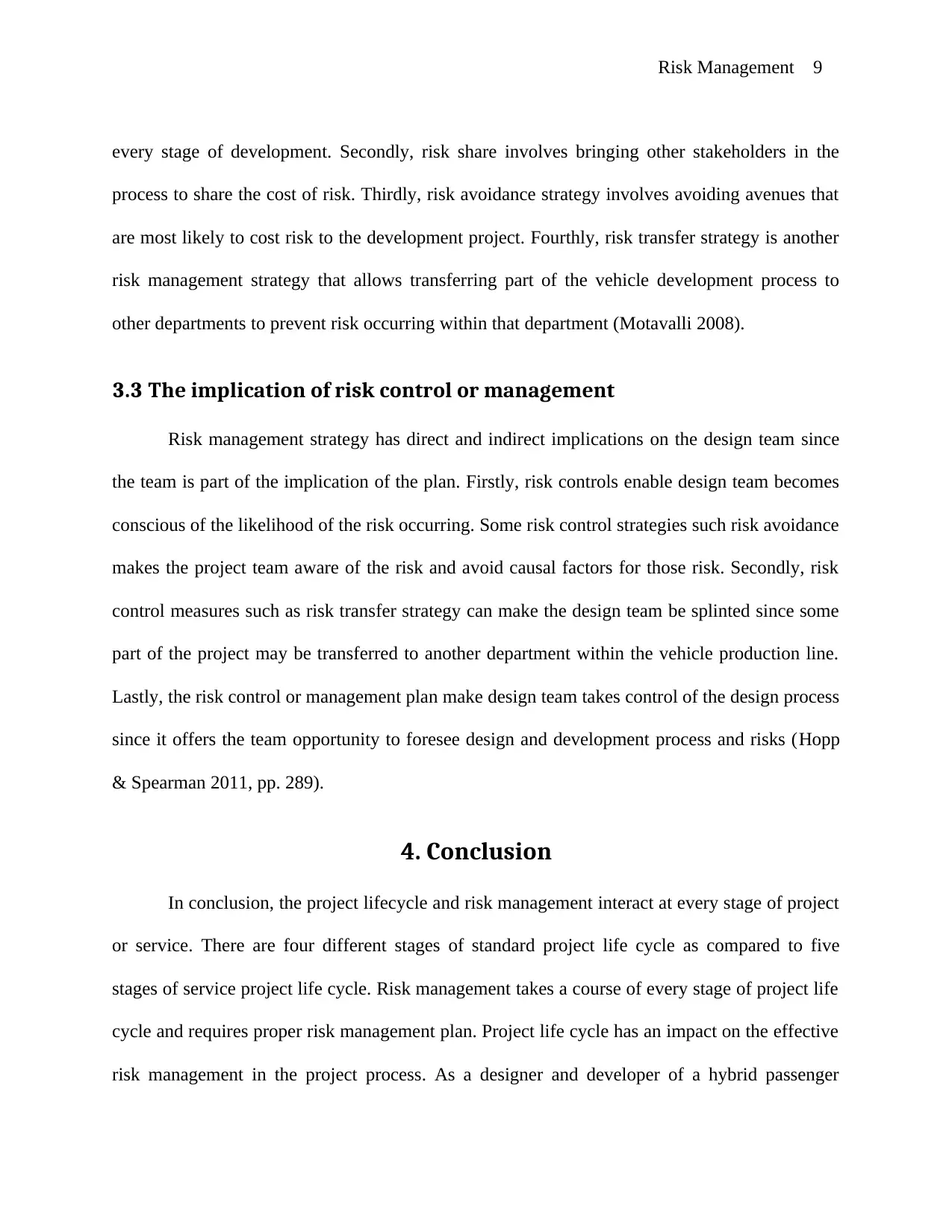
Risk Management 9
every stage of development. Secondly, risk share involves bringing other stakeholders in the
process to share the cost of risk. Thirdly, risk avoidance strategy involves avoiding avenues that
are most likely to cost risk to the development project. Fourthly, risk transfer strategy is another
risk management strategy that allows transferring part of the vehicle development process to
other departments to prevent risk occurring within that department (Motavalli 2008).
3.3 The implication of risk control or management
Risk management strategy has direct and indirect implications on the design team since
the team is part of the implication of the plan. Firstly, risk controls enable design team becomes
conscious of the likelihood of the risk occurring. Some risk control strategies such risk avoidance
makes the project team aware of the risk and avoid causal factors for those risk. Secondly, risk
control measures such as risk transfer strategy can make the design team be splinted since some
part of the project may be transferred to another department within the vehicle production line.
Lastly, the risk control or management plan make design team takes control of the design process
since it offers the team opportunity to foresee design and development process and risks (Hopp
& Spearman 2011, pp. 289).
4. Conclusion
In conclusion, the project lifecycle and risk management interact at every stage of project
or service. There are four different stages of standard project life cycle as compared to five
stages of service project life cycle. Risk management takes a course of every stage of project life
cycle and requires proper risk management plan. Project life cycle has an impact on the effective
risk management in the project process. As a designer and developer of a hybrid passenger
every stage of development. Secondly, risk share involves bringing other stakeholders in the
process to share the cost of risk. Thirdly, risk avoidance strategy involves avoiding avenues that
are most likely to cost risk to the development project. Fourthly, risk transfer strategy is another
risk management strategy that allows transferring part of the vehicle development process to
other departments to prevent risk occurring within that department (Motavalli 2008).
3.3 The implication of risk control or management
Risk management strategy has direct and indirect implications on the design team since
the team is part of the implication of the plan. Firstly, risk controls enable design team becomes
conscious of the likelihood of the risk occurring. Some risk control strategies such risk avoidance
makes the project team aware of the risk and avoid causal factors for those risk. Secondly, risk
control measures such as risk transfer strategy can make the design team be splinted since some
part of the project may be transferred to another department within the vehicle production line.
Lastly, the risk control or management plan make design team takes control of the design process
since it offers the team opportunity to foresee design and development process and risks (Hopp
& Spearman 2011, pp. 289).
4. Conclusion
In conclusion, the project lifecycle and risk management interact at every stage of project
or service. There are four different stages of standard project life cycle as compared to five
stages of service project life cycle. Risk management takes a course of every stage of project life
cycle and requires proper risk management plan. Project life cycle has an impact on the effective
risk management in the project process. As a designer and developer of a hybrid passenger
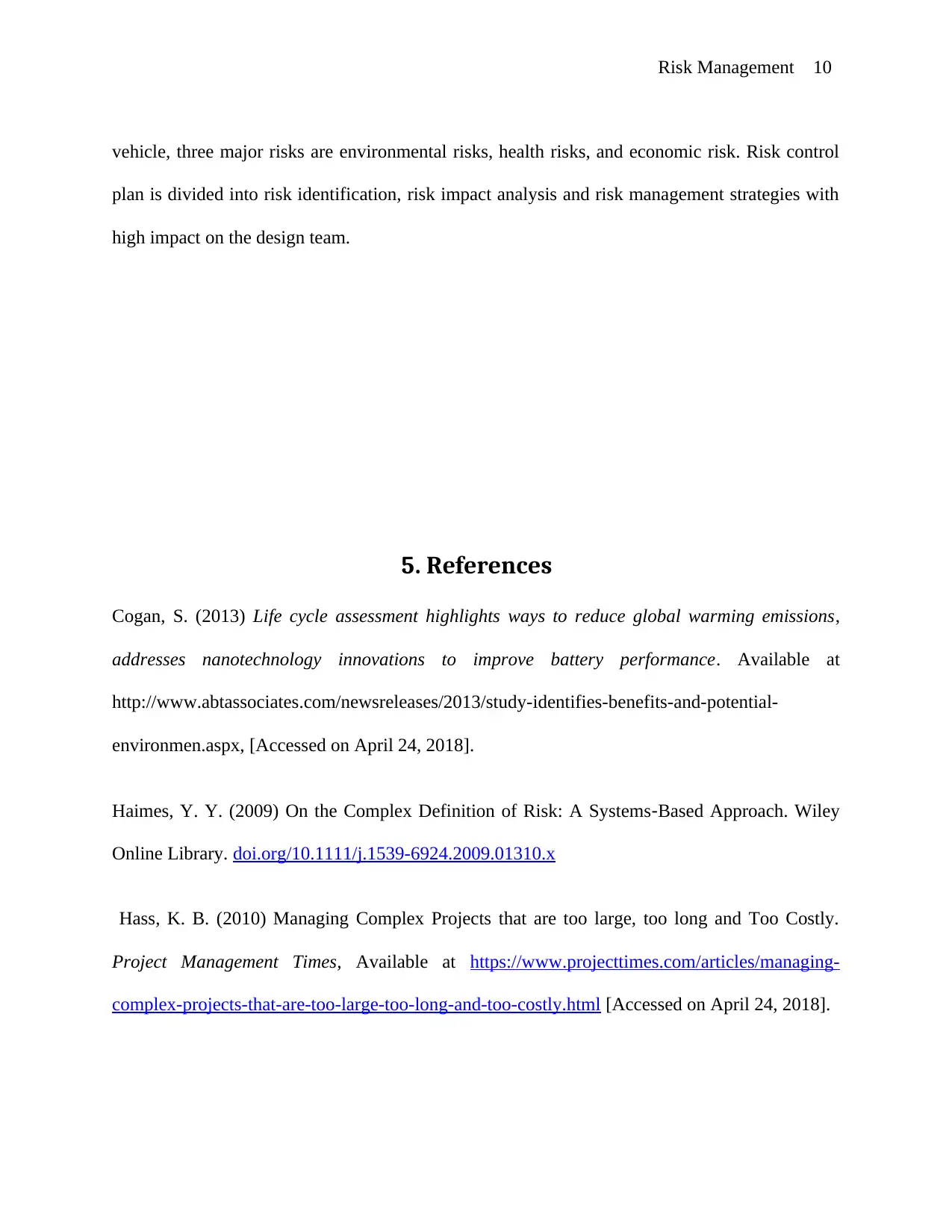
Risk Management 10
vehicle, three major risks are environmental risks, health risks, and economic risk. Risk control
plan is divided into risk identification, risk impact analysis and risk management strategies with
high impact on the design team.
5. References
Cogan, S. (2013) Life cycle assessment highlights ways to reduce global warming emissions,
addresses nanotechnology innovations to improve battery performance. Available at
http://www.abtassociates.com/newsreleases/2013/study-identifies-benefits-and-potential-
environmen.aspx, [Accessed on April 24, 2018].
Haimes, Y. Y. (2009) On the Complex Definition of Risk: A Systems‐Based Approach. Wiley
Online Library. doi.org/10.1111/j.1539-6924.2009.01310.x
Hass, K. B. (2010) Managing Complex Projects that are too large, too long and Too Costly.
Project Management Times, Available at https://www.projecttimes.com/articles/managing-
complex-projects-that-are-too-large-too-long-and-too-costly.html [Accessed on April 24, 2018].
vehicle, three major risks are environmental risks, health risks, and economic risk. Risk control
plan is divided into risk identification, risk impact analysis and risk management strategies with
high impact on the design team.
5. References
Cogan, S. (2013) Life cycle assessment highlights ways to reduce global warming emissions,
addresses nanotechnology innovations to improve battery performance. Available at
http://www.abtassociates.com/newsreleases/2013/study-identifies-benefits-and-potential-
environmen.aspx, [Accessed on April 24, 2018].
Haimes, Y. Y. (2009) On the Complex Definition of Risk: A Systems‐Based Approach. Wiley
Online Library. doi.org/10.1111/j.1539-6924.2009.01310.x
Hass, K. B. (2010) Managing Complex Projects that are too large, too long and Too Costly.
Project Management Times, Available at https://www.projecttimes.com/articles/managing-
complex-projects-that-are-too-large-too-long-and-too-costly.html [Accessed on April 24, 2018].
Secure Best Marks with AI Grader
Need help grading? Try our AI Grader for instant feedback on your assignments.
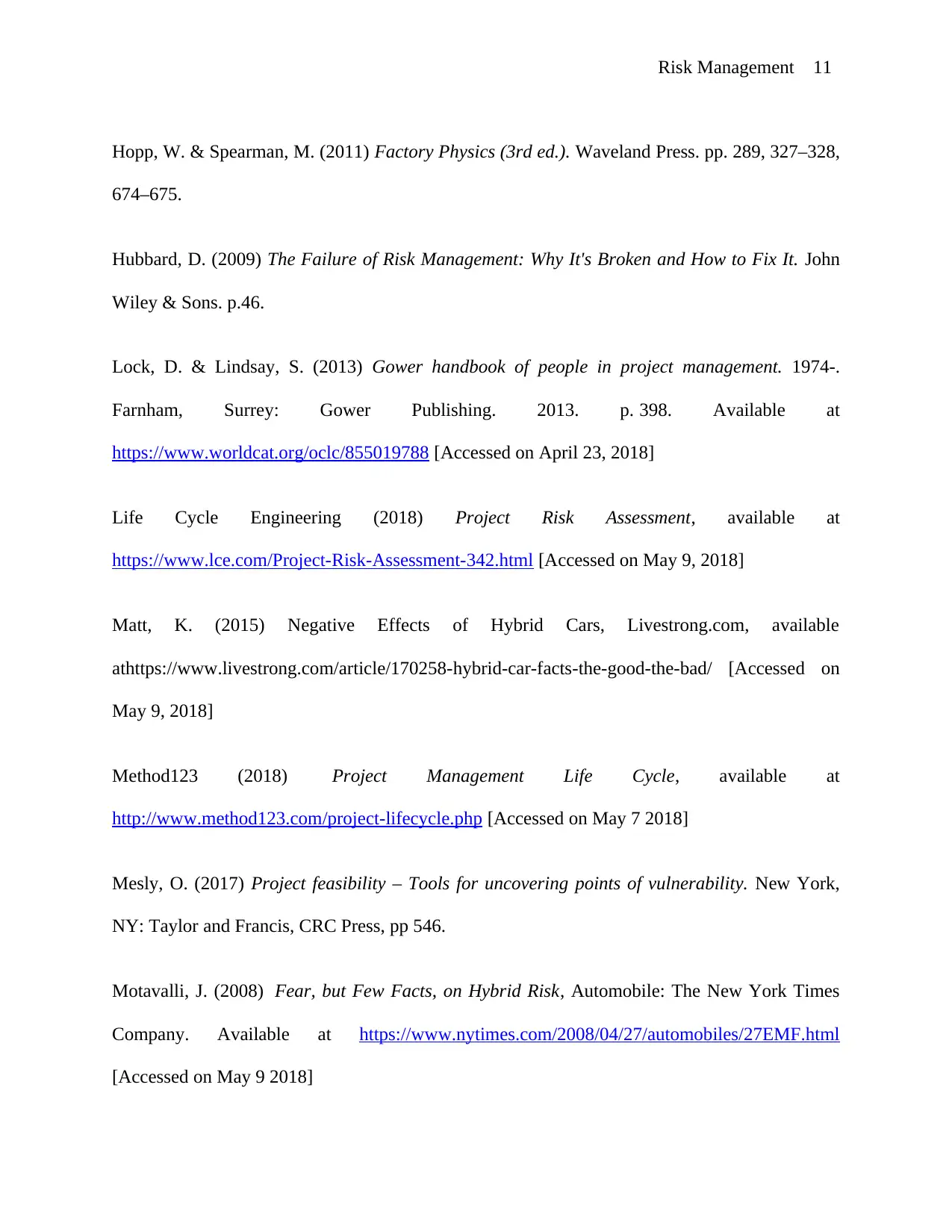
Risk Management 11
Hopp, W. & Spearman, M. (2011) Factory Physics (3rd ed.). Waveland Press. pp. 289, 327–328,
674–675.
Hubbard, D. (2009) The Failure of Risk Management: Why It's Broken and How to Fix It. John
Wiley & Sons. p.46.
Lock, D. & Lindsay, S. (2013) Gower handbook of people in project management. 1974-.
Farnham, Surrey: Gower Publishing. 2013. p. 398. Available at
https://www.worldcat.org/oclc/855019788 [Accessed on April 23, 2018]
Life Cycle Engineering (2018) Project Risk Assessment, available at
https://www.lce.com/Project-Risk-Assessment-342.html [Accessed on May 9, 2018]
Matt, K. (2015) Negative Effects of Hybrid Cars, Livestrong.com, available
athttps://www.livestrong.com/article/170258-hybrid-car-facts-the-good-the-bad/ [Accessed on
May 9, 2018]
Method123 (2018) Project Management Life Cycle, available at
http://www.method123.com/project-lifecycle.php [Accessed on May 7 2018]
Mesly, O. (2017) Project feasibility – Tools for uncovering points of vulnerability. New York,
NY: Taylor and Francis, CRC Press, pp 546.
Motavalli, J. (2008) Fear, but Few Facts, on Hybrid Risk, Automobile: The New York Times
Company. Available at https://www.nytimes.com/2008/04/27/automobiles/27EMF.html
[Accessed on May 9 2018]
Hopp, W. & Spearman, M. (2011) Factory Physics (3rd ed.). Waveland Press. pp. 289, 327–328,
674–675.
Hubbard, D. (2009) The Failure of Risk Management: Why It's Broken and How to Fix It. John
Wiley & Sons. p.46.
Lock, D. & Lindsay, S. (2013) Gower handbook of people in project management. 1974-.
Farnham, Surrey: Gower Publishing. 2013. p. 398. Available at
https://www.worldcat.org/oclc/855019788 [Accessed on April 23, 2018]
Life Cycle Engineering (2018) Project Risk Assessment, available at
https://www.lce.com/Project-Risk-Assessment-342.html [Accessed on May 9, 2018]
Matt, K. (2015) Negative Effects of Hybrid Cars, Livestrong.com, available
athttps://www.livestrong.com/article/170258-hybrid-car-facts-the-good-the-bad/ [Accessed on
May 9, 2018]
Method123 (2018) Project Management Life Cycle, available at
http://www.method123.com/project-lifecycle.php [Accessed on May 7 2018]
Mesly, O. (2017) Project feasibility – Tools for uncovering points of vulnerability. New York,
NY: Taylor and Francis, CRC Press, pp 546.
Motavalli, J. (2008) Fear, but Few Facts, on Hybrid Risk, Automobile: The New York Times
Company. Available at https://www.nytimes.com/2008/04/27/automobiles/27EMF.html
[Accessed on May 9 2018]
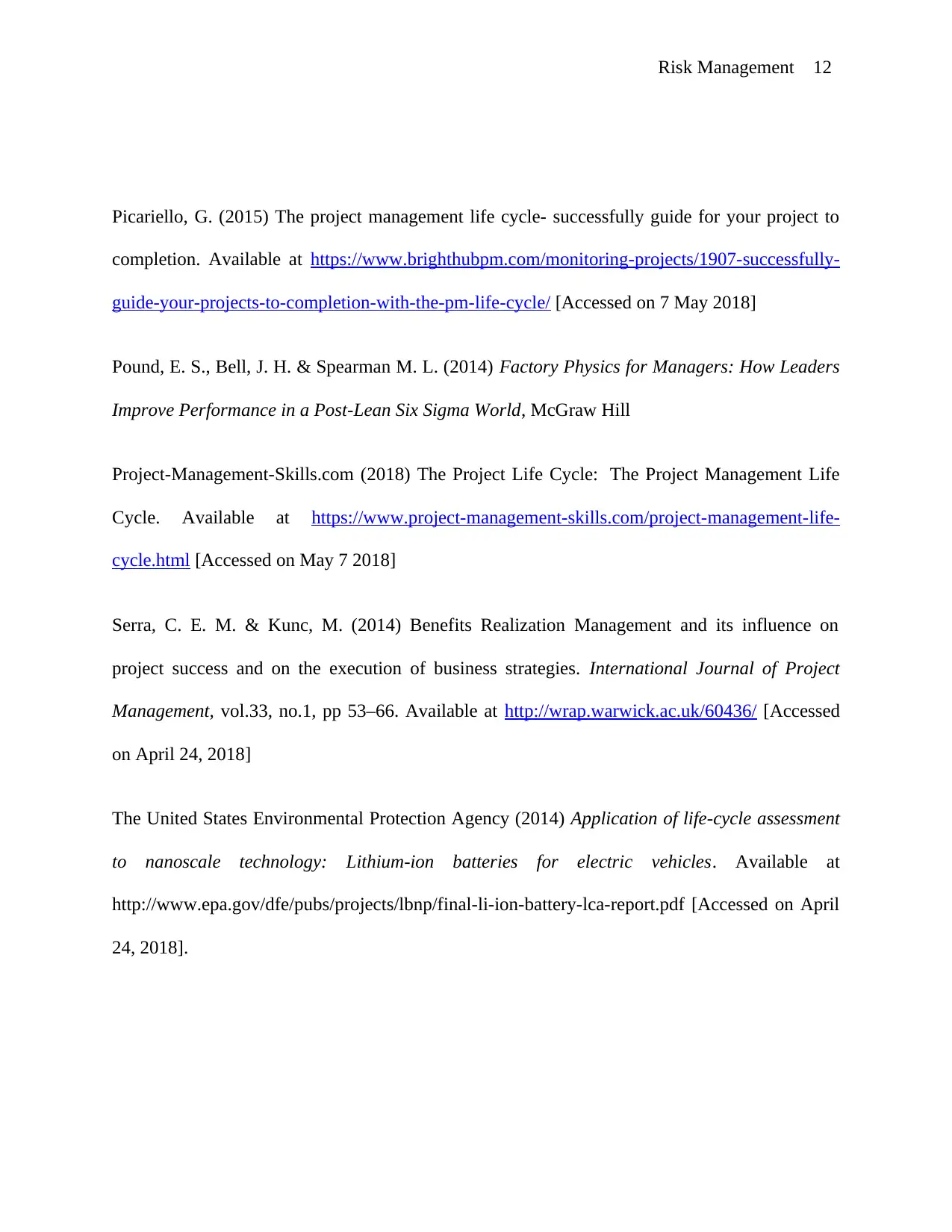
Risk Management 12
Picariello, G. (2015) The project management life cycle- successfully guide for your project to
completion. Available at https://www.brighthubpm.com/monitoring-projects/1907-successfully-
guide-your-projects-to-completion-with-the-pm-life-cycle/ [Accessed on 7 May 2018]
Pound, E. S., Bell, J. H. & Spearman M. L. (2014) Factory Physics for Managers: How Leaders
Improve Performance in a Post-Lean Six Sigma World, McGraw Hill
Project-Management-Skills.com (2018) The Project Life Cycle: The Project Management Life
Cycle. Available at https://www.project-management-skills.com/project-management-life-
cycle.html [Accessed on May 7 2018]
Serra, C. E. M. & Kunc, M. (2014) Benefits Realization Management and its influence on
project success and on the execution of business strategies. International Journal of Project
Management, vol.33, no.1, pp 53–66. Available at http://wrap.warwick.ac.uk/60436/ [Accessed
on April 24, 2018]
The United States Environmental Protection Agency (2014) Application of life-cycle assessment
to nanoscale technology: Lithium-ion batteries for electric vehicles. Available at
http://www.epa.gov/dfe/pubs/projects/lbnp/final-li-ion-battery-lca-report.pdf [Accessed on April
24, 2018].
Picariello, G. (2015) The project management life cycle- successfully guide for your project to
completion. Available at https://www.brighthubpm.com/monitoring-projects/1907-successfully-
guide-your-projects-to-completion-with-the-pm-life-cycle/ [Accessed on 7 May 2018]
Pound, E. S., Bell, J. H. & Spearman M. L. (2014) Factory Physics for Managers: How Leaders
Improve Performance in a Post-Lean Six Sigma World, McGraw Hill
Project-Management-Skills.com (2018) The Project Life Cycle: The Project Management Life
Cycle. Available at https://www.project-management-skills.com/project-management-life-
cycle.html [Accessed on May 7 2018]
Serra, C. E. M. & Kunc, M. (2014) Benefits Realization Management and its influence on
project success and on the execution of business strategies. International Journal of Project
Management, vol.33, no.1, pp 53–66. Available at http://wrap.warwick.ac.uk/60436/ [Accessed
on April 24, 2018]
The United States Environmental Protection Agency (2014) Application of life-cycle assessment
to nanoscale technology: Lithium-ion batteries for electric vehicles. Available at
http://www.epa.gov/dfe/pubs/projects/lbnp/final-li-ion-battery-lca-report.pdf [Accessed on April
24, 2018].
1 out of 12
Related Documents
Your All-in-One AI-Powered Toolkit for Academic Success.
+13062052269
info@desklib.com
Available 24*7 on WhatsApp / Email
![[object Object]](/_next/static/media/star-bottom.7253800d.svg)
Unlock your academic potential
© 2024 | Zucol Services PVT LTD | All rights reserved.





